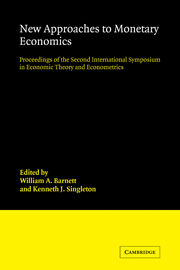 New Approaches to Monetary Economics
New Approaches to Monetary Economics Book contents
- Frontmatter
- Contents
- Editors' introduction
- List of contributors
- Part I Transactions motivated monetary holdings in general equilibrium
- Part II Financial intermediation
- 4 Preference shocks, liquidity, and central bank policy
- 5 Banking and macroeconomic equilibrium
- Part III Monetary aggregation theory
- Part IV Issues on aggregate fluctuations
- Part V Theoretical issues in the foundations of monetary economics and macroeconomics
4 - Preference shocks, liquidity, and central bank policy
Published online by Cambridge University Press: 04 August 2010
- Frontmatter
- Contents
- Editors' introduction
- List of contributors
- Part I Transactions motivated monetary holdings in general equilibrium
- Part II Financial intermediation
- 4 Preference shocks, liquidity, and central bank policy
- 5 Banking and macroeconomic equilibrium
- Part III Monetary aggregation theory
- Part IV Issues on aggregate fluctuations
- Part V Theoretical issues in the foundations of monetary economics and macroeconomics
Summary
Abstract: We characterize the role of a central bank as a mechanism designer for risk-sharing across banks that are subject to privately observed “liquidity shocks.” The optimal mechanism involves borrowing/lending from a “discount window.” The optimal discount rate and the induced distortions in holdings of liquid assets suggest a rationale for subsidized lending and reserve requirements on the observable part of liquid asset holdings.
Introduction
Several recent papers have examined the micro-theoretic foundations for a theory of financial intermediation. The role of intermediaries as agents who provide delegated monitoring services has been developed in Leland and Pyle (1977) and Diamond (1984). More recently, Bryant (1980) and Diamond and Dybvig (1983) have considered issues pertaining to the optimal form of intermediary (deposit) contracts. They examine intertemporal models in which depositors are subject to privately observed preference shocks and the returns to investments depend on their time to maturity (liquidity). Within this framework, Bryant, Diamond-Dybvig and Jacklin (1986) have demonstrated the superiority of deposit contracts over Walrasian (mutual fund) trading mechanisms in providing agents with insurance for risks connected with preference shocks.
The work on banking contracts has also served to focus attention on problems of coordination across agents who have private information on (risky) investments undertaken by the depository intermediaries or mutual funds. The pioneering study of Bryant (1980) considered the instabilities (panics) and imperfect risk-sharing that would arise if bank depositors (with fixed commitment contracts) make earlier withdrawals based on information about asset returns.
- Type
- Chapter
- Information
- New Approaches to Monetary EconomicsProceedings of the Second International Symposium in Economic Theory and Econometrics, pp. 69 - 88Publisher: Cambridge University PressPrint publication year: 1987
- 215
- Cited by


